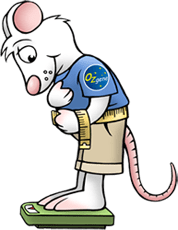Putting the squeeze on obesity
Putting the squeeze on obesity
In this issue
Feature
Publications
Frank’s blog
Geneoz VMS news
Did you know?
Newsletter feedback
 Putting the squeeze on obesity
Putting the squeeze on obesity
What determines how much fat is stored on our bodies? That’s a question many people would like the answer to. Professor Herbert Herzog, from Sydney’s Garvan Institute of Medical Research, along with several of his colleagues, has set out to find some answers.
For over 25 years, Professor Herzog has been committed to neurobiology research. His focus has been on determining the processes that can lead to the development of obesity, anorexia and type 2 diabetes. Dr Herzog has used transgenic and knockout mouse models to investigate how the body clock regulates fat production, how natural gut hormones could be used to treat obesity, how certain molecules can turn appetite on or off, and the link between stress and obesity, just to name a few.
In his most recent research, featuring a mouse model generated by Ozgene, Dr Herzog focused on stress and diet induced fat gain. Neuropeptide Y (NPY) has been extensively studied and is known to play a critical role in energy homeostasis and stress-coping. Dr Herzog and his colleagues set out to investigate the specific effects of catecholaminergic NPY on energy homeostasis along with the critical role of the catecholaminergic system in maintaining homeostasis during stress. The results showed that catecholaminergic NPY activity has significant impact on body weight and adiposity under both an obesogenic diet and stressful conditions.
The scientific publication on this study is featured in the publications below.
More information on Professor Herzog’s research can be found on the Garvan Institute website.
More information on Ozgene’s custom designed knockout, knock-in and transgenic mice can be found on Ozgene services.
Latest publications
Brain. 2014 Jun 1.
Reduced dendritic arborization and hyperexcitability of pyramidal neurons in a Scn1b-based model of Dravet syndrome.
Reid CA, Leaw B, Richards KL, Richardson R, Wimmer V, Yu C, Hill-Yardin EL, Lerche H, Scheffer IE, Berkovic SF, Petrou S.
University of Melbourne, Australia; University of Tübingen, Germany; University of Ulm, Germany. [read]
J Peripher Nerv Syst. 2014 May 23.
Characterization of the Mitofusin 2 R94W Mutation in a Knock-in Mouse Model.
Strickland AV, Rebelo AP, Zhang F, Price J, Bolon B, Silva JP, Wen R, Züchner S.
University of Miami, FL, United States. [read]
Featured: Molecular Metabolism. 2014 May 16.
Stress- and diet-induced fat gain is controlled by NPY in catecholaminergic neurons.
Lei Zhang L, Lee ICJ, Enriquez RF, Lau J, Vähätalo LH, Baldock PA, Savontaus E, Herzog H.
Garvan Institute of Medical Research, Sydney, Australia. [read]
ACS Med. Chem. Lett. 2014 May 8.
Optimization of GPR40 Agonists for Type 2 Diabetes.
Liu J, Wang Y, Ma Z, Schmitt M, Zhu L, Brown SP, Dransfield PJ, Sun Y, Sharma R, Guo Q, Zhuang R, Zhang J, Luo J, Tonn GR, Wong S, Swaminath G, Medina JC, Lin DCH, Houze JB.
Amgen Inc., South San Francisco, CA, United States. [read]
Frank’s blog – Absolutely f…ing awesome!
Pardon my English but that was my email to the Ozgene team this morning when they told me about the latest results. We are not quite ready to launch our new aptly named goGermline technology yet. I, however, just can’t quell my enthusiasm, so here it goes ….
Geneoz VMS News
Geneoz VMS now allows users to subscribe to notifications when project milestones are reached and when tasks are opened, rescheduled or completed. These notifications are available on email, SMS or iPhone app. The alerts will soon be implemented for Ozgene clients, allowing them to follow their project progress in real time.
Did you know?
An Ozgene mouse model is published every 12 days, with over 240 research papers published by our clients utilising Ozgene mouse models.
Feedback
What do you think about our new style newsletter? What would you like to see in the next issue? Send us an email and let us know.

 Putting the squeeze on obesity
Putting the squeeze on obesity
